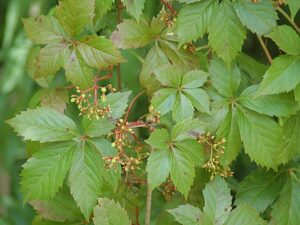 In my garden beds, I generally consider Virginia creeper—Parthenocissus quinquefolia—to be a nuisance. The seeds, “planted” by passing birds that eat and excrete the fall berries, germinate readily in inaccessible places like the base of the privet hedge that bounds three sides of the front yard. Disguised by the privet leaves, the fast-sprouting creeper vines are therefore invisible until the fateful day when they reach the top of the hedge and protrude over it. Then I have to insert my hands, and sometimes my head, into the privet hedge, trace the vines back to the ground and attempt to dig or yank them out. This is generally less than successful, since the creeper inevitably resprouts and renews its skyward journey.
In my garden beds, I generally consider Virginia creeper—Parthenocissus quinquefolia—to be a nuisance. The seeds, “planted” by passing birds that eat and excrete the fall berries, germinate readily in inaccessible places like the base of the privet hedge that bounds three sides of the front yard. Disguised by the privet leaves, the fast-sprouting creeper vines are therefore invisible until the fateful day when they reach the top of the hedge and protrude over it. Then I have to insert my hands, and sometimes my head, into the privet hedge, trace the vines back to the ground and attempt to dig or yank them out. This is generally less than successful, since the creeper inevitably resprouts and renews its skyward journey.
Recently though, I had to reconsider my biases about the plant that is sometimes commonly known as “woodbine”. I was out walking with my daughter and she noticed loose clusters of small, blue berries borne on red stems that were attached to a vine draped expansively over a stone wall. The vine’s leaves were mostly desiccated, so the berries were noticeable. “They are beautiful,” said my daughter, “What are they?” A check of the withered leaves confirmed my suspicions. The berries belonged to a Virginia creeper vine that was experiencing its last moments of glory before settling down for the winter.
Anyone familiar with wild grapes would note that the little grapes resemble the non-edible creeper berries. This is because Virginia creeper and wild grapes are close relations within the grape or Vitaceae family. Both bear palmate leaves, but creeper leaves are compound, composed of five leaflets apiece. In fact the five-leafed structure is one of the key identifiers for Virginia creeper, distinguishing it from other, similar vines.
People who grow up in rural or suburban areas know that a vine with clusters of three leaves is probably poison ivy and should be avoided. A similar vine with clusters of five leaves is Virginia creeper—just as vigorous as poison ivy, but less likely to produce an itchy rash.
Native plant enthusiasts find it easy to love Virginia creeper, which occurs naturally throughout the eastern and central United States and south as far as Mexico. Not only is it an excellent habitat plant, providing food and cover for small animals and birds, but it flourishes in just about any soil and climate situation and requires minimal care. It will even tolerate life in the vicinity of the toxin-emitting roots of the black walnut tree. In fact, the only thing the average gardener will have to do about this vine is trim it to keep it within bounds. Left to its own devices, a healthy Virginia creeper will climb or sprawl up to 50 feet. This is great if you have an embankment with erosion problems, or a large structure to cover. The plant is extremely enterprising, having evolved to clamber upwards by clinging to whatever it touches by means of adhesive pads on the tips of the tendrils. These do not infiltrate mortar or other porous surfaces, like some ivies, but they can be damaging to painted surfaces.
Virginia creeper is beautiful under any circumstances. The deciduous leaves emerge bronze-purple in spring, before turning to medium green during the later spring and summer months. Small, greenish white flowers also appear in the spring, but they are relatively insignificant. The vine’s seasonal apotheosis happens at the end of summer or the earliest days of fall, when those five-petaled leaves turn brilliant red. Plants that have flourished as supporting players suddenly experience a transcendent moment of stardom, glowing in the sun. The moment happens to plants grown in semi-shade as well, but the fall color may not be quite as vivid.
Once the fall show is over, the leaves brown out, leaving the berries to end the season. They will eventually fall from the vines if they haven’t already been eaten and distributed by birds. If you are growing the plants on purpose, be mindful of the fact that little Virginia creepers will likely sprout all over your property every year. These are easy to grub out if you find them as they emerge in the spring. In fact, if you are hoping to install a Virginia creeper to cover your pergola, garage wall or unsightly rubbish pile, find a friend or neighbor who already grows one. The neighbor will probably be happy to give you two or three or twenty self-sown creeper plants.
No plant is ever perfect, no matter what the vendors tell you, but under the right circumstances, Virginia creeper can beautify your space.
And your local bird population will thank you.
